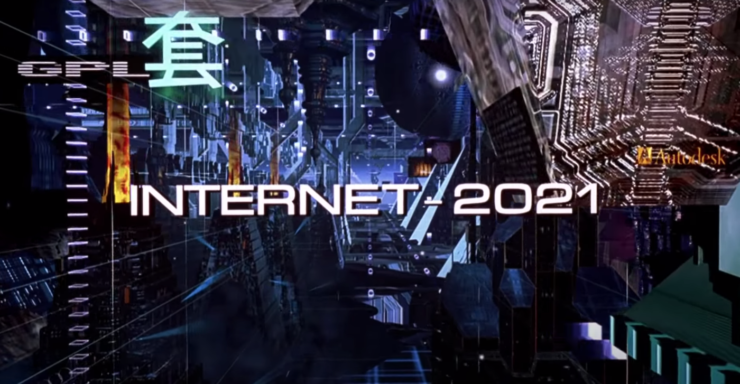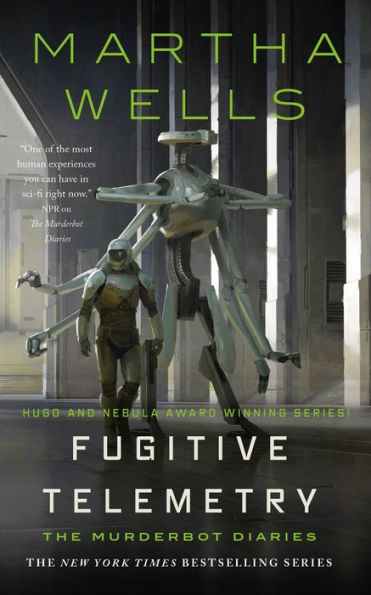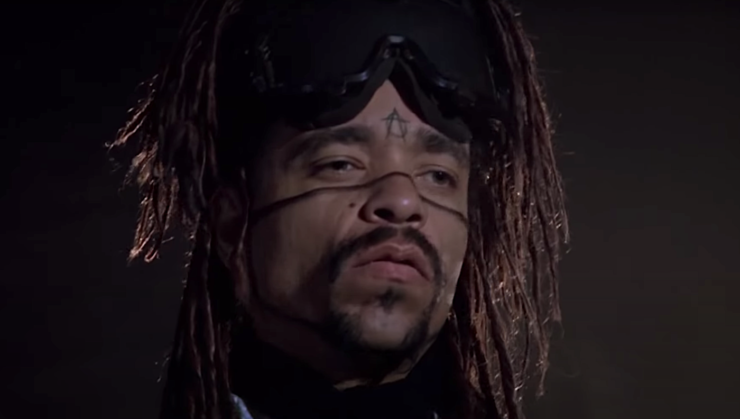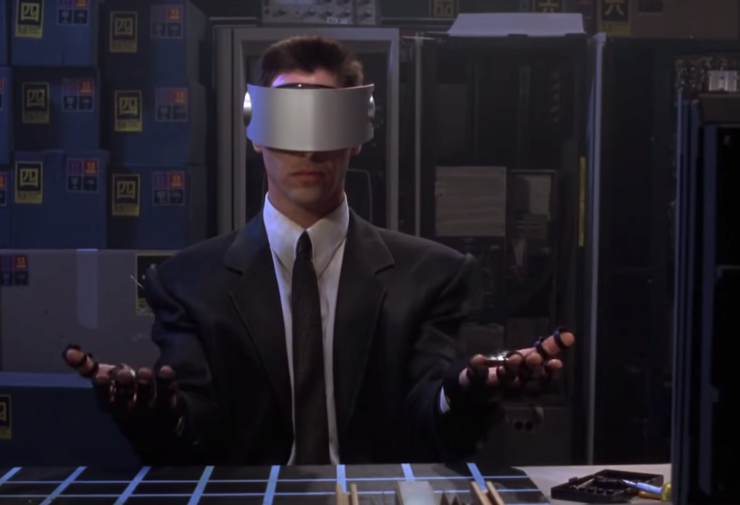In May 1995 we received a bold vision of the future. A glittering world where physical cities merged with cities on the internet. Where bodyguards wore chainmail tank tops and carried pink, glitter-encrusted hand grenades. Where payphones still existed but you could phreak them with mobile, red plastic phones… which were almost as large and conspicuous as the payphones themselves. Where mini-discs were successful.
And the more I think about it, this vision wasn’t just a cyberpunk lark, it was a warning. A bleating klaxon of what awaited us.
That warning was Johnny Mnemonic.
Our tale begins in May 1981, in an issue of OMNI.
William Gibson published a short story called “Johnny Mnemonic”, about a data smuggler who was trying to deliver a transmission he was carrying in his head before an assassin got to him. Along the way he’s protected by a bodyguard, the violence-besotted Molly Millions, who has cybernetic mirrors implanted in her eyes and daggers embedded under her fingernails.
(Molly Millions is my second favorite Molly, after Templeton, Tolsky, McGhee, and Majumder, who are all tied for #1.)
The story tears through a simple plot with stops along the way for futuristic tech, an anarchist village of people called Lo-Teks, a battle in a synthesizer-strewn thunderdome, and a smack-addled cybernetic dolphin. The story was included in Burning Chrome, and a few years later Gibson brought Molly back for Neuromancer. Fourteen years later, after cyberpunk imagery had shown up in a ton of movies, “Johnny Mnemonic” finally got a film adaptation directed by painter Robert Longo and starring Keanu Reeves.
It was a critical failure (and added a lot of fodder to the myth that Keanu Reeves is a terrible actor), but the movie is perpetually rediscovered by people who notice parallels with The Matrix, or trash like me who like to make list posts out of ’90s cyberpunk movies.

A few weeks ago our production manager pointed out that Johnny Mnemonic takes place in 2021. Then I saw that it in fact takes place specifically on January 17, 2021. I thought it would be fun to once again point and laugh at the movie. But the more I thought about it the more I realized it was a prescient call for sanity, and if we’d listened to it, we’d be a lot better off.
Buy the Book


Fugitive Telemetry
I’ll start with the villains, of which there are five. And while you could look at that number and say, “That is at least four too many,” I think the movie (granted, probably inadvertently) makes an extremely good point by giving us a cluster of interconnected villains rather than the single assassin from the story.
Villain #1 is a disease called “nerve attenuation syndrome,” a degenerative neurological disorder caused by, basically, too much exposure to the internet—media over-saturation as pandemic. The disease is also called NAS or “Black Shakes,” and it disproportionately afflicts people who use cybernetic enhancements to make a living, who are then too sick to make enough money to afford treatment. This leads us to Villain #2: Pharmakom, a literal Big Pharma that has a cure for NAS, but chooses to dole out expensive temporary treatments rather than make the cure freely available to those who need it. Villains #3 and #4 are Takahashi and Shinji, one of the heads of Pharmakom and a hired Yakuza assassin, respectively. When Shinji doesn’t immediately get the job done, Takahashi calls in Villain #5, a volatile religious fanatic called Street Preacher. Preacher is more than happy to take his brand of Christian Nationalism to its extreme, casting himself as a warrior sent by God to punish anyone who crosses him. Conveniently ignoring the Gospels’ (very clear!) anti-murder stance, he in fact behaves more like a Roman executioner, torturing his victims with crucifixion.
All of these villains come together in a clusterfuck of an ending—but that’s also kind of the point.
Capitalism run rampant has given us an unchecked corporatocracy that controls people’s lives as insidiously as an authoritarian government would, but under an illusion of freedom. It feeds on people’s addiction to tech, and then refuses to cure them when the addiction starts killing them. It weaponizes both traditional criminal organizations and religious extremism as necessary.
Who is opposing the villains?
A clutch of good-hearted renegade scientists, who want to get their NAS cure to the public despite their terror of getting caught. A doctor who not only works underground to help the poor, but ultimately uses his body as a shield to protect his patients from the aforementioned religious fanatic. Anti-government protesters who diligently wear N95 masks as they gather in front of the Pharmakom building. A multiracial coalition of the poor who have rejected the excesses of tech to subvert the corporatocracy. Jane, the film’s slightly less violence-besotted version of Molly Millions, is sick with the Black Shakes, so we can see how it impacts her ability to work and function in society. And there’s that kick-ass dolphin, who is still cybernetic, but not addicted to heroin—I assume a studio exec got nervous, at that point.
And, yes, the doctor is played by Henry Rollins, and does this:
And yes, the Lo-Teks are led by Ice-T, who hadn’t quite become the actor he has on Law & Order: SVU.

But it’s still an ultimately optimistic view of the future, that shows the majority of people believing a deadly virus is real and actively combatting it.
We’re all carrying far more than 80 gigs of data in our heads at all times now. If my friends are any kind of representative sample, those of us who are lucky enough to work from home spend our days in front of screens, doomscrolling and/or trying to help children learn via Zoom in between stabs at production. If you have to go out into the world to work, you’re at the mercy of a capitalist system that won’t even guarantee health care or an efficient vaccine rollout.
Johnny Mnemonic promised us wetware, physical implants that would give us added strength and quicker reflexes, and brain implants that would allow us to hold a whopping 80 gigs of data in our heads. What did we get instead? My beloved friend and colleague Emmet had a massive brain emergency last year, and now they have a shunt.
A SHUNT.
Can they jack into the internet with a shunt? No.
Can they crash people’s entire boards with that shunt? Nope.
Can they commune with cybernetic dolphins with that shunt? Not even a little! All the stupid thing is good for is staying alive, apparently.
Oh, and speaking of the cybernetic dolphin?
What we got instead, here in the real world, was someone vandalizing a manatee.
‘Cause that’s the future we’ve ended up in. Some people have worked incredibly hard to try to give us something better, but at every point bullies and con men have dragged us back down into the muck.
What I wanted was the cool blue. The neon and the hi/lo of an opera singer with Manic Panic hair crooning over a beat in a nightclub. I wanted the ideal that a scrappy kid like Johnny who described breaking and entering as “a summer job” could get to the bottom rung of the higher class, and then come to his senses and ally with the Lo-Teks. I wanted the fantasy that the most powerful man in the movie would spend his dying breath helping people instead of grasping after power like a Skeksis. That the people would band together and rise up in non-violent protest.
Okay, that one actually happened. And we all saw the response. And we’re all seeing the response to the Mirror World inversion of those protests.
I’ll admit that at this point I do not have 80 gigs of hope left. Or energy, or will, or enthusiasm. I am getting up every day and trying to do each tiny thing I can think of to at least get us up to a Lo-Tek level of future, if not the excellent opera nightclub level. And since I refuse to end on a note of desolation, I want to return to what I still believe is one of the greatest scenes in cinematic history:
By way of transcription:
Johnny Mnemonic: What the fuck is going on? WHAT THE FUCK IS GOING ON? You know, all my life, I’ve been careful to stay in my own corner. Looking out for Number One… no complications. Now, suddenly, I’m responsible for the entire fucking world! And everybody and his mother is trying to kill me, IF… IF… my head doesn’t blow up first.
Jane: Maybe it’s not just about you any more.
Johnny: Listen. You listen to me. You see that city over there?
…
That’s where I’m supposed to be. Not down here with the dogs, and the garbage, and the fucking last month’s newspapers blowing back and forth. I’ve had it with them, I’ve had it with you, I’ve had it with all this. I want… ROOM SERVICE!!! I want the club sandwich! I want the cold! Mexican! Beer! I want a 10,000 a night hookerrrr![Johnny pauses, looks down, tucks his shirt into his pants.]
“I want my shirts laundered… like they do… at the Imperial Hotel… in Tokyo.”
Let’s unpack this.
Here we have a person who has created a niche for himself where he is simultaneously extremely privileged, and ludicrously exploited. His class markers are those of a child: I, too, thought club sandwiches were chic when my grandmother used to take me to lunch, when I was seven years old. Where the $10,000 dollar-a-night hooker would rent their body, Johnny rents his brain, and attaches his sense of the self- worth to the fact that he can afford the 10K. He doesn’t say he wants his clothes tailored, or that he wants designer fashion—only that he likes the way they’re cleaned at a particular hotel. A name-brand hotel, which he can drop and expect everyone around him to agree to its quality—like Hans Gruber admiring Mr. Takagi’s suits, or, I don’t know, a failed tyrant attaching his name to every building he can find in a naked attempt to deny his mortality.
Obviously in the long run this never works.
Or, maybe not obviously?
I’ll admit that over the last few weeks my gallows humor has stretched, snapped, and left me blinking on the ground.
But if you’ll allow me some intricate pop cultural knotwork: Johnny’s arc is to go from being a person whose sense of self and meaning revolves around these status symbols. He starts the film claiming that he looks out for Number 1, but he’s also very hung up on other peoples’ perceptions of him, on belonging in an elite world of shining cities and first-class plane tickets. The first time we see him he is literally climbing above, and looking down upon, a crowd of masked protesters who are demanding a cure to NAS. By the end of the film? He’s realized that he is, in fact, responsible for the entire fucking world. If he can do it, maybe the rest of us can?
If a ridiculous (but awesome) ’90s cyberpunk movie can write a hopeful future, why can’t we? In a world full of assassins and Street Preachers, isn’t it better to fight for the workers and the doctors and Ice-T?
Isn’t it better to create a future worthy of a telepathic dolphin?
Leah Schnelbach wants a better future even more than a cold Mexican beer. Come communicate with them through the S.Q.U.I.D. that is Twitter!










